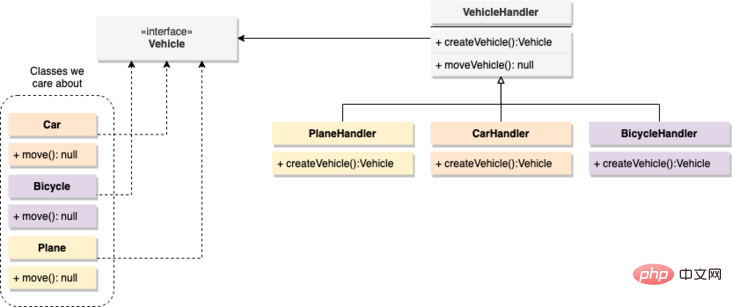 <p>设计模式是可以帮助开发人员解决问题的模板。在本中涉及的模式太多了,而且它们往往针对不同的需求。但是,它们可以被分为三个不同的组:
<p>设计模式是可以帮助开发人员解决问题的模板。在本中涉及的模式太多了,而且它们往往针对不同的需求。但是,它们可以被分为三个不同的组:
Composite、Adapter和Decorator。观察者模式。class MyDBConn {
protected static instance: MyDBConn | null = null
private id:number = 0
constructor() {
this.id = Math.random()
}
public getID():number {
return this.id
}
public static getInstance():MyDBConn {
if (!MyDBConn.instance) {
MyDBConn.instance = new MyDBConn()
}
return MyDBConn.instance
}
}
const connections = [
MyDBConn.getInstance(),
MyDBConn.getInstance(),
MyDBConn.getInstance(),
MyDBConn.getInstance(),
MyDBConn.getInstance()
]
connections.forEach( c => {
console.log(c.getID())
})getInstance方法,可以确保不会有多个实例。在上面的示例中,可以看到包装数据库连接的伪类如何从该模式中获益。<p>这个事例展示了无论我们调用getInstance方法多少次,这个连接总是相同的。<p>上面的运行结果:0.4047087250990713 0.4047087250990713 0.4047087250990713 0.4047087250990713 0.4047087250990713
工厂模式是一种创建模式,就像单例模式一样。但是,这个模式并不直接在我们关心的对象上工作,而是只负责管理它的创建。<p>解释一下:假设我们通过编写代码来模拟移动车辆,车有很多类型,例如汽车、自行车和飞机,移动代码应该封装在每个vehicle类中,但是调用它们的move 方法的代码可以是通用的。<p>这里的问题是如何处理对象创建?可以有一个具有3个方法的单一creator类,或者一个接收参数的方法。在任何一种情况下,扩展该逻辑以支持创建更多vehices都需要不断增长相同的类。<p>但是,如果决定使用工厂方法模式,则可以执行以下操作:<p> <p>现在,创建新对象所需的代码被封装到一个新类中,每个类对应一个车辆类型。这确保了如果将来需要添加车辆,只需要添加一个新类,而不需要修改任何已经存在的东西。<p>接着来看看,我们如何使用
<p>现在,创建新对象所需的代码被封装到一个新类中,每个类对应一个车辆类型。这确保了如果将来需要添加车辆,只需要添加一个新类,而不需要修改任何已经存在的东西。<p>接着来看看,我们如何使用TypeScript来实现这一点:interface Vehicle {
move(): void
}
class Car implements Vehicle {
public move(): void {
console.log("Moving the car!")
}
}
class Bicycle implements Vehicle {
public move(): void {
console.log("Moving the bicycle!")
}
}
class Plane implements Vehicle {
public move(): void {
console.log("Flying the plane!")
}
}
// VehicleHandler 是“抽象的”,因为没有人会实例化它instantiate it
// 我们要扩展它并实现抽象方法
abstract class VehicleHandler {
// 这是真正的处理程序需要实现的方法
public abstract createVehicle(): Vehicle
public moveVehicle(): void {
const myVehicle = this.createVehicle()
myVehicle.move()
}
}
class PlaneHandler extends VehicleHandler{
public createVehicle(): Vehicle {
return new Plane()
}
}
class CarHandler extends VehicleHandler{
public createVehicle(): Vehicle {
return new Car()
}
}
class BicycleHandler extends VehicleHandler{
public createVehicle(): Vehicle {
return new Bicycle()
}
}
/// User code...
const planes = new PlaneHandler()
const cars = new CarHandler()
planes.moveVehicle()
cars.moveVehicle()vehicle类型,所要做的就是添加它的vehicle类和它的处理程序类,而不增加任何其他类的LOC。观察者模式,因为类型的行为我们可以实现它。<p>它是如何工作的呢?本质上,该模式表明你拥有一组观察者对象,这些对象将对被观察实体状态的变化做出反应。为了实现这一点,一旦在被观察端接收到一个更改,它就负责通过调用它的一个方法来通知它的观察者。<p>在实践中,此模式的实现相对简单,让我们快速查看一下代码,然后回顾一下type InternalState = {
event: String
}
abstract class Observer {
abstract update(state:InternalState): void
}
abstract class Observable {
protected observers: Observer[] = []
protected state:InternalState = { event: ""}
public addObserver(o: Observer):void {
this.observers.push(o)
}
protected notify () {
this.observers.forEach(o => o.update(this.state))
}
}
class ConsoleLogger extends Observer {
public update(newState: InternalState) {
console.log("New internal state update: ", newState)
}
}
class InputElement extends Observable {
public click():void {
this.state = { event: "click" }
this.notify()
}
}
const input = new InputElement()
input.addObserver(new ConsoleLogger())
input.click()Observer,该观察者将表示对Observable实体上的更改做出反应的对象。 在上面的示例中,我们假设具有一个被单击的InputElement实体(类似于在前端具有HTML输入字段的方式),以及一个ConsoleLogger,用于记录控制台发生的所有事情。<p>这种模式的优点在于,它使我们能够了解Observable的内部状态并对其做出反应,而不必弄乱其内部代码。 我们可以继续添加执行其他操作的观察者,甚至包括对特定事件做出反应的观察者,然后让它们的代码决定对每个通知执行的操作。move方法的Dog类,现在您想扩展其行为,因为我们想要一只超级狗和一只可以游泳的狗。<p>通常,我们需要在 Dog 类中添加move 行为,然后以两种方式扩展该类,即SuperDog和SwimmingDog类。 但是,如果我们想将两者混合在一起,则必须再次创建一个新类来扩展它们的行为,但是,有更好的方法。<p>组合让我们可以将自定义行为封装在不同的类中,然后使用该模式通过将原始对象传递给它们的构造函数来创建这些类的新实例。 让我们看一下代码:abstract class Animal {
abstract move(): void
}
abstract class SuperDecorator extends Animal {
protected comp: Animal
constructor(decoratedAnimal: Animal) {
super()
this.comp = decoratedAnimal
}
abstract move(): void
}
class Dog extends Animal {
public move():void {
console.log("Moving the dog...")
}
}
class SuperAnimal extends SuperDecorator {
public move():void {
console.log("Starts flying...")
this.comp.move()
console.log("Landing...")
}
}
class SwimmingAnimal extends SuperDecorator {
public move():void {
console.log("Jumps into the water...")
this.comp.move()
}
}
const dog = new Dog()
console.log("--- Non-decorated attempt: ")
dog.move()
console.log("--- Flying decorator --- ")
const superDog = new SuperAnimal(dog)
superDog.move()
console.log("--- Now let's go swimming --- ")
const swimmingDog = new SwimmingAnimal(dog)
swimmingDog.move()SuperDecorator类扩展了Animal类,与Dog类扩展了相同的类。 这是因为装饰器需要提供与其尝试装饰的类相同的公共接口。SuperDecorator类是abstract ,这意味着并没有使用它,只是使用它来定义构造函数,该构造函数会将原始对象的副本保留在受保护的属性中。 公共接口的覆盖是在自定义装饰器内部完成的。SuperAnimal和SwimmingAnimal是实际的装饰器,它们是添加额外行为的装饰器。Animal类,因此如果你要将两种行为混合在一起,则可以执行以下操作:const superSwimmingDog = new SwimmingAnimal(superDog) superSwimmingDog.move()
<p>等标签定义一些格式,然后格式之间互相组合,通过一种递归的方式组织成相应的结构,这种方式其实就是组合,将部分的组件镶嵌到整体之中。<p>关于此模式的有趣之处在于,它不是一个简单的对象组,它可以包含实体或实体组,每个组可以同时包含更多组,这就是我们所说的树。<p>看一个例子:interface IProduct {
getName(): string
getPrice(): number
}
class Product implements IProduct {
private price:number
private name:string
constructor(name:string, price:number) {
this.name = name
this.price = price
}
public getPrice():number {
return this.price
}
public getName(): string {
return this.name
}
}
class Box implements IProduct {
private products: IProduct[] = []
contructor() {
this.products = []
}
public getName(): string {
return "A box with " + this.products.length + " products"
}
add(p: IProduct):void {
console.log("Adding a ", p.getName(), "to the box")
this.products.push(p)
}
getPrice(): number {
return this.products.reduce( (curr: number, b: IProduct) => (curr + b.getPrice()), 0)
}
}
//Using the code...
const box1 = new Box()
box1.add(new Product("Bubble gum", 0.5))
box1.add(new Product("Samsung Note 20", 1005))
const box2 = new Box()
box2.add( new Product("Samsung TV 20in", 300))
box2.add( new Product("Samsung TV 50in", 800))
box1.add(box2)
console.log("Total price: ", box1.getPrice())product 放入Box中,也可以将Box放入其他Box中,这是组合的经典示例。因为我们要实现的是获得完整的交付价格,因此需要在大box里添加每个元素的价格(包括每个小box的价格)。<p>上面运行的结果:Adding a Bubble gum to the box Adding a Samsung Note 20 to the box Adding a Samsung TV 20in to the box Adding a Samsung TV 50in to the box Adding a A box with 2 products to the box Total price: 2105.5
<p>英文原文地址:https://blog.bitsrc.io/design-patterns-in-typescript-e9f84de40449 <p>作者:Fernando Doglio <p>译者:前端小智<p>更多编程相关知识,请访问:编程视频!!
以上是深入了解TypeScript中的5种设计模式的详细内容。更多信息请关注PHP中文网其他相关文章!

